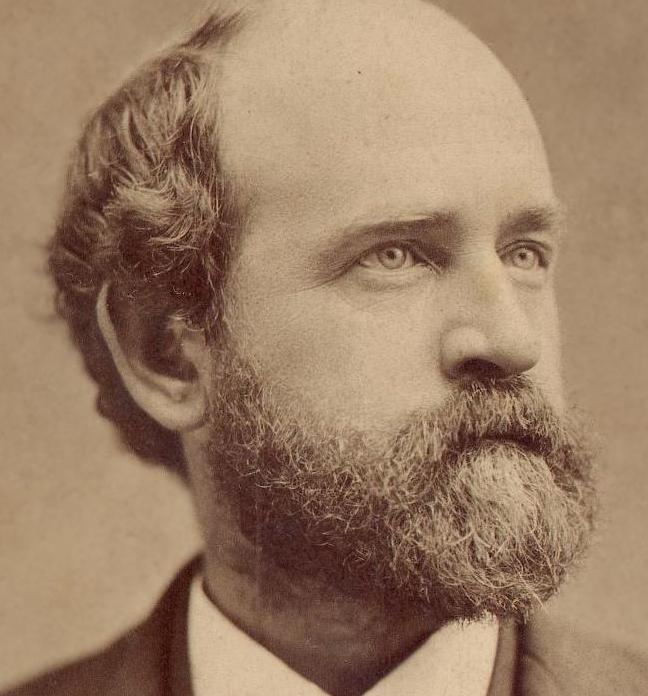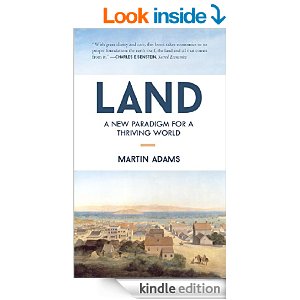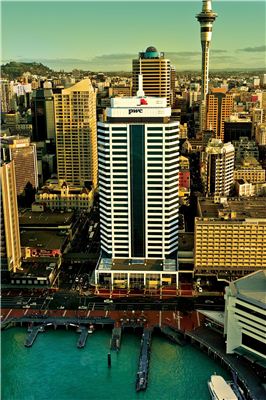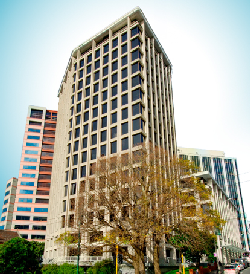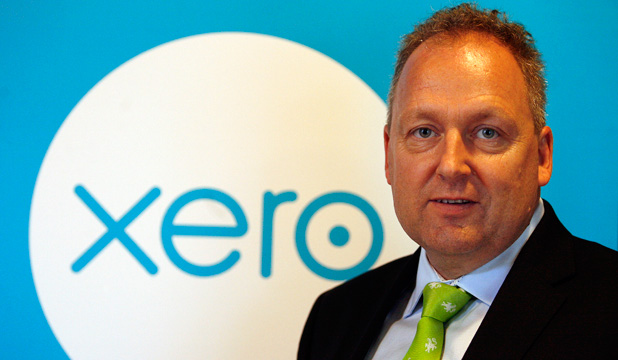The so-called discipline of economics has been systematically corrupted in two major ways: first to get rid of the word ‘land’ from the very language of economics and second to downplay, omit or misrepresent any discussion of the words ‘credit’, ‘banking’ and ‘money’. They shamelessly describe banks as intermediaries when they know this is a minor function and that bank’s major function is money creation. Fortunately the story behind the flagrant omission of land as a factor of production has now emerged, while the money story remains for some enterprising researcher in the future, (though various DVDs and stories hint in that direction).
The Corruption of Economics by Mason Gaffney and Fred Harrison, while free online, is hardly known; as of December 2015 only three New Zealand university libraries and the Auckland Public Library held copies. Yet in it is a very important story.
Fred Harrison describes the phenomenon of Henry George, the San Francisco journalist who took the world by storm with his book Progress and Poverty in 1879, in which he argues that the benefits of land ownership must be shared by all and that a single tax is needed to fund government – a land tax. The factors of production are land, capital and labour. Untax labour and tax land was the cry. Poverty could be beaten. Social justice was possible!
Of Henry George influential economic historian John Kenneth Galbraith writes,
In his time and even into the 1920s and 1930s Henry George was the most widely read of American economic writers both at home and in Europe. He was, indeed, one of the most widely read of Americans. Progress and Poverty… in various editions and reprintings… had a circulation in the millions.
Unlike many writers, Henry George didn’t stop there. He took his message of hope everywhere he could travel – across America and to England, New Zealand, Australia, Scotland and Ireland. He turned political. Seven years after his book came out in remote California, in 1886 he narrowly missed out on being elected Mayor of New York, outpolling Teddy Roosevelt. During the 1890s George, Henry George was the third most famous American, after Mark Twain and Thomas Edison. Ten years after Progress and Poverty he was influencing a radical wing of the British Liberal Party. He was read by semi-literate workers from Birmingham, Alabama to Liverpool, England. His Single Tax was understood by peasants in the remotest crofts of Scotland and Ireland.
Gaffney’s section of the book outlines how certain rich land barons, industrialists and bankers funded influential universities in America and proceeded to change the direction of their economics departments. He names names at every turn, wading through presidents and funders of many prestigious universities. In particular, Gaffney, an economist himself, names the economists bought to discredit Henry George’s theories, their debates with George and their papers written over many decades.
‘George’s ideas were carried worldwide by such towering figures as Lloyd George in England, Leo Tolstoy and Alexander Kerensky in Russia, Sun Yat-sen in China, hundreds of local and state and a few power national politicians in both Canada and the USA, Billy Hughes in Australia, Rolland O’Regan in New Zealand, Chaim Weizmann in Palestine, Francisco Madero in Mexico, and many others in Denmark, South Africa and around the world. In England Lloyd George’s budget speech of 1909 reads in part as though written by Henry George himself. Some of Winston Churchill’s speeches were written by Georgist ghosts.’
When he died there were 100,000 at his funeral.
The wealthy and influential just couldn’t let the dangerous ideas spread. Their privileged position was gravely threatened. Henry George must be stopped. But the strategy had to be subtle. What better route than by using their money to influence the supposed fount of all knowledge, the universities? That would then indoctrinate journalists and the general public. Nice one!
The story explains how, for their wealthy paymasters, academics corrupted the language to subsume land under capital as a factor of production. They redefined rent, and created a jargon to confuse public debate. Harrison says, ‘For a century they have taken people down blind alleys with abstract models and algebraic equations. Economics became detached from the real world in the course of the twentieth century.’
Yes, the wealthy paid money to buy scholars to pervert the science.
Gaffney’s rich, whimsical language is a joy to read. He writes to Harrison,
‘Systematic, universal brainwashing is the crime, tendentious mental conditioning calculated to mislead students, to impoverish their mental ability, to bend their minds to the service of a system that funnels power and wealth to a parasitic minority.’
He painstakingly describes the funding of various American universities by such figures as JP Morgan and John D Rockefeller who choose the President who obligingly appoints suitable head economists to key academic positions. Gaffney trawls through the writings of key figures in neoclassical economics over many decades, quoting numerous pieces attacking Henry George and his Single Tax proposal. Several neoclassical economists actually debated George in person. These early neoclassical economists were J B Clark, Philip Wicksteed, Alfred Marshall, ERA Seligman and Francis A Walker, who each contributed something to ‘addle, baffle, boggle and dazzle the laity’. J B Clark, for instance, has a bibliography that quotes at least 24 works directed against George over a span of 28 years.
Banker JP Morgan funnelled his wealth through Seth Low to Columbia University in New York, and John D Rockefeller did the same in Chicago. Ezra Cornell, who Gaffney says once held one million acres of land, creator of the Western Union Monopoly, founded Cornell University in Ithaca, New York State. Leland Stanford of Southern Pacific Railroad (really a land company), funded Stanford University. Johns Hopkins University in Baltimore, Maryland was endowed by Johns Hopkins, millionaire merchant and investor.
Each of these benefactors appointed their own president. Hopkins appointed Daniel Gilman as President. Out of that university came eleven Presidents of the American Economics Association. Gilman had a natural hatred of Henry George as he had been hounded out of Berkeley by the crusading young journalist when he uncovered ‘Gilman’s improper diversion of the Morrill Act funds.’
In his chapter entitled The Chicago School Poison, Gaffney writes:
John D Rockefeller funded Chicago spectacularly in 1892, and started raiding other campuses by raising salaries. Rockefeller picked the first President, William Rainey Harper. Harper picked the first economist, J Laurence Laughlin, from Andrew Dickson White’s Cornell (he liked Laughlin’s rigid conservative and anti-populist views. Harper drove out Veblen in 1906, then died, leaving Laughlin in charge of economics until he retired in 1916. He passed the torch to J. M. Clark, the son and collaborator of J.B.Clark. Frank Knight came to Chicago in 1917 from Laughlin’s Cornell. The apostolic succession is very clear from Rockefeller to Harper to Laughlin to Clark to Knight. …Chicago to this day is still the lengthened shadow of John D Rockefeller.
In terms of numbers, and intensity of feeling generated, Knight probably produced more neoclassical economists than anyone in history. He made no secret of his firm opposition to Henry George and ideas that might comfort Georgists. His enduring interest and his viewpoint are clear from the title “Fallacies in the Single Tax” (1953)
Who would have thought nowadays that Henry George had to be neutralised? After all, he wrote his books and did his public speaking and touring from 1870 to 1897.
It was in these five Universities that neoclassical economics developed to the stage where it has almost completely taken over from classical economics, and it was out of these universities that the American Association of Economists was founded in 1885 by Ely, Walker, Edwin Seligman and others. He notes they did not welcome ‘reformers’.
In addition, Richard Ely retired after a long career a John Hopkins University, to establish what he called The Institute for Research in Land and Public Utilities whose purpose was ‘to investigate all problems connected with land taxation’. Contributors included utilities, railways, building and loan associations, land companies, lumbermen, farmers, bankers, lawyers and insurance men.
At least two of these academics were wealthy – E R A Seligman of Columbia came from a wealthy banking family. Richard Ely, who was known as the ‘Dean of American economists,’ was a well-connected land speculator, making a small fortune in Wisconsin real estate. He spent his life rationalising land speculation.
To give you another taste of Gaffney (take a big breath): ‘To most modern readers, probably George seems too minor a figure to have warranted such an extreme reaction. This impression is a measure of the neo-classicals’ success; it is what they sought to make of him. It took a generation, but by 1930 they had succeeded in reducing him in the public mind. In the process of succeeding, however, they emasculated the discipline, impoverished economic thought, muddled the minds of countless students, rationalised free-riding by landowners, took dignity from labour, rationalised chronic unemployment, hobbled us with today’s counterproductive tax tangle, marginalised the obvious alternative system of public finance, shattered our sense of community, subverted a rising economic democracy for the benefit of rent-takers and led us into becoming an increasingly nasty and dangerously divided plutocracy.’
Let’s turn a blind eye to money too
The omission of the words credit, banking and money or the downright distortion of facts in university teaching was also no accident. The publishing in 1906 of Silvio Gesell’s book The Natural Economic Order sparked a decades-long movement. Gesell has been described by Irving Fisher as a ‘strangely neglected prophet’. John Maynard Keynes wrote, ‘I believe that the future will learn more from the spirit of Gesell than from that of Marx.’
For centuries American politicians and British politicians had been treating money creation as a political issue.Thomas Jefferson and Abraham Lincoln are two who knew that banks create money. But after the arrival of neoclassical economics in the late nineteenth century, things started to change. To please the banks who profit from land ownership, mention of the words ‘money’, ‘credit’ and ‘banking’ was also omitted, especially after the widespread influence of both Major CH Douglas from the 1920s and Silvio Gesell’s advocacy of a decaying currency. It was a bit worrying for banks that the Social Credit Party in New Zealand won 12% of the vote in 1953. So a Royal Commission on Banking and Credit was set up. In 1956 it found that banks were ‘banks of issue as well as banks of deposit’. However, thanks to their spin doctors, politicians their managed to misrepresent the findings well enough for the public to believe the Commission had ruled the opposite. Who knows what mischief went on behind the scenes? Universities fell into line. Academic teaching on money creation was reduced to a brazenly inaccurate paragraph or two, misleading generations of students. But money is really created by private banks as interest-bearing debt. This writes in a growth imperative, ensuring we depend on exponentially growing debt and continue to monetise and privatise the commons.
If universities are a vehicle for spreading misinformation about how money is created we can more easily understand the simple and chilling statement of Mayer Amschel Rothschild , “Let me issue and control a nation’s money and I care not who writes the laws.”
Predicting the Global Financial Crisis
The corruption of economics in universities is no trivial matter. Economic crises are serious matter involving loss of homes, savings and jobs and economists need the right tools to predict them so they can deal with them. Tragically only a handful of economists predicted the Global Financial Crisis of 2007-8 and the Queen of England was known to ask, ‘Why didn’t anyone see this coming?’ Professor Steve Keen in his book Debunking Economics spends a chapter summarising the work of a Dutch economist, Dr Dirk Bezemer. After laying down certain criteria for selection, he concludes there were only 12 (two published together). He named Dean Baker, Wynne Godley, Fred Harrison (UK), Michael Hudson, Eric Janszen, Steve Keen (Australia), Jakob Madsen & Jens Kjaer Sørensen (Denmark), Kurt Richebächer, Nouriel Roubini, Peter Schiff and Robert Shiller. Subsequently Bezemer had the list at three dozen, but out of a total profession of at least 20,000 it is a very dismal record. If any other profession (e.g medicine) was so wrong in something that affected millions they would be sued. The universities who train economists should hang their heads in shame.
Hyman Minsky claimed that in prosperous times, when corporate cash flow rises beyond what is needed to pay off debt, a speculative euphoria develops, and soon thereafter debts exceed what borrowers can pay off from their incoming revenues, which in turn produces a financial crisis. He said we moved from a hedging stage where risk is low to a speculative stage and finally to a Ponzi stage. A key indicator was the growth of private debt as a fraction of GDP. The “Bezemer 12” quoted above had in common that they were concerned with the distinction between the financial economy (making money from money) and the real economy. Keen wrote in 2009, “Unfortunately after the crisis everything being done by policy makers around the world is instead trying to restart private borrowing.” Sadly Wikipedia notes that while Minsky’s theories have enjoyed some popularity, they have had little influence in mainstream economics or in central bank policy.
These same people are among those now warning of a very much larger international financial collapse, as debt deflation takes hold and ongoing globalisation locks the global economy ever more tightly together. Economics is too important to be left to mistaught economists. The absence of good, reality-based economic theory in education leaves millions of environmental and social activists – along with the compassionate right – to flounder about helplessly trying to solve growing inequality and the climate crisis.
Challenging the universities
Tackling the veracity of university teaching in economics is no job for a quitter. In 2013 a retired engineer started on a mission when he read the Bank of England paper on money creation. Peter Morgan wrote to the Vice-Chancellor of Auckland University, Professor Ananish Chaudhuri:
‘The textbook used by the University of Auckland for its macroeconomics courses is Principles of Macroeconomics in New Zealand, by N. Gregory Mankiw, Debasis Bandyopadhyay and Paul Wooding. It contains several statements that are unequivocally fallacious. By way of example – by no means the only one in the textbook – the following is an example:
“Financial intermediaries are financial institutions through which savers can indirectly provide funds to borrowers.”’
He went on to quote from both the Royal Commission on Banking and Credit in New Zealand in 1956, but mostly from the Bank of England papers e.g. Banks are not intermediaries of loanable funds – and why this matters by Zoltan Jakab and Michael Kumhof
Back came his answer:-
“Dear Mr Morgan:
Thank you for your recent letter to the Vice Chancellor which has now been sent on to me via the Dean of the Business School.
First of all, thank you for taking the time to write.
I begin by noting that the questions you have raised go to the heart of the debate raging around the world. There is no question that in the aftermath of the GFC, the state of macroeconomics globally is in a flux with possibly more questions than answers. As you must be well aware leading scholars as well as policy makers are currently engaged in a robust debate world-wide particularly as Greece and Germany enter into a stare-down which may result in the break-up of the European currency union.
Having said that let me make a few points:
First, the textbook at issue is the most popular textbook world-wide including most leading institutions of higher learning. Greg Mankiw is a leading scholar, a professor at Harvard (which I believe also teaches from this text) and was Chairman of George W. Bush’s Council of Economic Advisors. I expect that he is well aware of the state of the art in terms of both the theory and policy-making. There are local editions of this book written by leading scholars in those countries. The Australian edition was done by Joshua Gans of Melbourne and Stephen King (till recently Dean at Monash Business School). Their role is to provide a local perspective and local data but the major intellectual force is provided by Mankiw. It is important to understand that the scholarship in this area is still very much evolving and therefore a plausible counter-argument is that no matter which text-book we choose to use, it will suffer from some flaws and deficiencies.
Second, while authors do their best to keep up with evolving knowledge nevertheless it takes time to update textbook content, at least partly because it takes time to understand and absorb the lessons of history. As I noted above the state of macroeconomics is in a flux and new research needs to be integrated into future editions.
Third, I would disagree that the book contains fundamental errors. I think this may have more to do with differences in assumptions and philosophies rather than violations of some universally held truths. We and indeed all scholars welcome robust debate on such differences. They are part and parcel of the academic discourse. As the VC has already pointed out, at the end of the day, this is also an issue of academic freedom. I have absolutely no reservations about the use of this textbook in our degree program.”
So having acknowledged that economists have spent a fruitless seven years scratching their heads about what caused the GFC, or the crisis in Greece, the Head of Department, Professor Chaudhuri puts this major issue aside and declares the book valuable. He justifies using a textbook with fundamental inaccuracies by saying other universities are doing it too! In a subsequent letter he confesses that he is not an expert in monetary policy. They often do that –claim they are not a macroeconomist. This is rather like the head of a medical school saying he is not an expert in medicine or the head of an architecture school saying he is not an expert in building design. The sheer nerve of senior economists to think that they don’t need to come to grips with monetary policy when the world is awash with debt would be incomprehensible if one didn’t know their very jobs depend on their pulling the party line. Money is at the heart of economic life.
Perhaps we can get some clarity from Steve Keen here. In a 2014 blog, he explains the three options open to universities after the 2014 Bank of England paper that refuted the loanable funds model. ‘Now if I believed in the tooth fairy, I would hope this emphatic denunciation of the textbook model would cause macroeconomics lecturers to drastically revise their lectures for next week. But I’m too long in the tooth to have such a delusion. They’ll ignore it instead. Their dominant “tactic” – if I can call it that – will be ignorance itself: most economics lecturers won’t even know that the bank’s paper exists, and they will continue to teach from whatever textbook bible they’ve chosen to inflict upon their students. A secondary one will be to know of it, but ignore it, as they’ve ignored countless critiques of mainstream economics before. The third arrow in the quill, if they are challenged by students about it (hint hint!), will be to argue that the textbook story is a “useful parable” for beginning students, and a more realistic version is introduced in more advanced courses.’
He seriously doubts if the paper will cause senior economists to change their current position and explains that until you know that banks can create and cancel money, you will never be able to understand how demand rises and falls. ‘All the parables of conventional economics fly out the window once you know this. The level of economic activity now depends on the lending decisions of banks (and the repayment decisions of borrowers). If banks lend more rapidly, or if borrowers repay more slowly, there will be a boom; if the reverse, there will be a slump. If new loans simply make up for old ones being repaid, then there is no effect, but if new loans exceed repayment then aggregate demand will increase.’
The urgency of getting this right
If universities are failing us by misleading our young people, journalists and politicians, think how critical it is to reverse this. Naomi Klein says that the climate crisis came along at the just the wrong time – when neoclassical economics was at its zenith. No wonder there was a reluctance to do anything meaningful as it simply clashed with the dominant economic paradigm. She says, ‘Economics is at war with the planet’. According to many experts there is only a small window to reverse climate change, until 2017.
There is a long way to go to reverse public thinking. Neoclassical (or neoliberal) economics has a death like grip on us. In over a century the doctrine has succeeded in further privatising the commons, dismantling the state, deregulating everything that moves and fooling the public over land and money. The economic theory that ignores the role of money and debt can’t possibly make sense of the economy in which we live. It should be jettisoned.
While the collapse of the global economy will be terribly painful and chaotic, it will certainly reduce carbon emissions dramatically. But as long as the economy holds up we need to get on our bikes and work. Whatever happens, no future economy should have the flaws we have now. It is time to get cracking, or as the sheep farmers of the South Island of New Zealand say – rattle our dags. We can do it.
Do universities lead advances in economics?
During depressions great thinking is done, sometimes in universities, but more often not. Henry George, a journalist, wrote Progress and Poverty in response to abject poverty in San Francisco (1879 book), Silvio Gesell, a German businessman, wrote after an Argentinian depression of the 1880 and 1890s and John Maynard Keynes wrote after the Great Depression of the 1930s. As we descend into worldwide debt deflation today’s searchers now must urgently find and implement a new economic model. And that will involve a huge shift in thinking.
Keynes suggestions were widely adopted after the Great Depression. In 1933-4 Gesell’s currency was put into practice in a small town in Austria with spectacular results. People came from all over Europe to witness the ‘miracle of Wørgl’. But it lasted a mere fifteen months, cut short by the influence of big banks over the Austrian government at the time, who made the ‘work certificates’ illegal. So despite considerable influence for three decades for his important thinking on currency design (a currency must only act as a medium of exchange and must rot like potatoes and rust like iron), Gesell is now all but forgotten. As central bankers grope helplessly for tools to stimulate the economy at the same time as controlling inflation, Gesell presents answers.
Gaffney’s description of how land barons, industrialists and bankers perverted university’s teaching, which in turn leads to wrong government policy, is reminiscent of the story of the history of banking. Banks have been a powerful influence on governments ever since governments allowed banks to create credit that could be used to pay taxes. This may have happened in Europe centuries ago after the goldsmiths.
To add to our troubles universities, under the influence of neoclassical economists, have all but stopped teaching economic history so no one can study Gesell or George.
The tie-up between universities and neoclassical economists also influences the relationship of politicians to bankers. Nomi Prins in her landmark book All the Presidents Bankers sheds light on the symbiotic relationship of a century of American presidents with the top bankers of the country, and how elite bankers can even dictate foreign policy. The dust cover of her book says she ‘ushers us into the intimate world of exclusive clubs, vacation spots, and Ivy League universities that binds presidents and financiers. She unravels the multi-generational blood, intermarriage, and protege relationships that have confined national influence to a privileged cluster of people. These families and individuals recycle their power through elected office and private channels in Washington, DC.’
Bankers admit they create money
Of course the bankers themselves know better than the universities who prefer to be complicit in keeping the secret. Graham Towers, Governor of the Bank of Canada and Lord Josiah Stamp of the Bank of England have been quoted regularly in the monetary reform literature. Even in New Zealand in 1955 we had H W White, Chairman of the Associated Banks telling the Royal Commission on Banking and Credit:
“The banks do create money. They have been doing it for a long time, but they didn’t realise it, and they did not admit it.”

